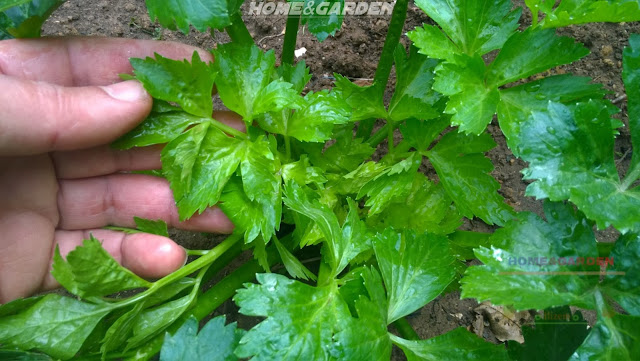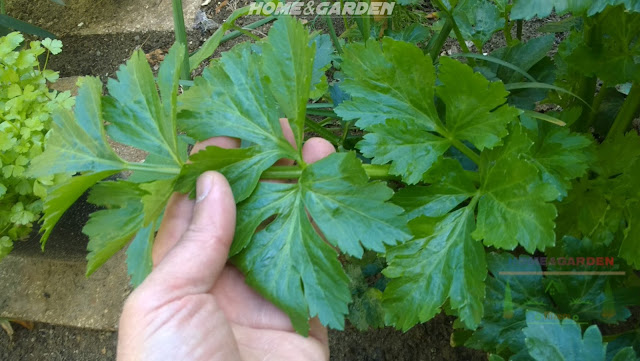Celery (Apium graveolens) is a member of the Umbelliferae or parsley family. Celery's common name comes from the French word "celeri" and the Italian word "seleri". Both were derived from the Greek word "selinon". Celery has been cultivated as a vegetable since antiquity. It is high in Vitamins B1 and B6, Vitamin C, calcium, fiber, folic acid, potassium, and antioxidants. Celery is one of the top traditional Mediterranean herbs recognized for its strong aromatic flavor, and can be used to a variety of cuisines. Eating celery will reduce high blood pressure risks, relief arthritis pain and suppress cancer cells growth.
Celeriac contains many anti-oxidants such as falcarinol, panaxydiol, falcarindiol, and methyl-falcarindiol. Several research studies from scientists found that these compounds possess anti-cancer properties and, may offer protection from colon cancer. Celeriac is an excellent source of some of the essential minerals such as phosphorus, iron, calcium, and manganese.
This aromatic herb is a good source of minerals like potassium, sodium, calcium, manganese, and magnesium. All these are an important component of cell and body fluids that helps regulate heart rate and blood pressure to maintain good health.
. History of Celery .
Celery is one of the oldest root vegetables in recorded history. This aromatic plant have been cultivated in the Mediterranean region for more than 3,000 years. Celery root first achieved culinary importance during the middle ages. Celery has been grown as a food crop for thousands of years. It has also had many other uses dating back to ancient times, including medicine. Celery is a vegetable that is popular with the health conscious. The Italians domesticated celery as a vegetable in the 17th century resulting in selections with solid stems. Early stalk celery had a tendency to produce hollow stalks. After many years of domestication, selection eliminated this characteristic as well as bitterness and strong flavors.
Early growers found that the naturally strong flavors could be diminished if grown in cooler conditions and also if blanched. Blanching is the practice of pushing dirt up around the base of the stalks to prevent sunlight from turning the stalks green.
Celery Varieties
Celery is grown for its succulent stalks or petioles, and was cultivated first not for its culinary use, but for its medicinal purposes. There are three different kinds of celery:
Leaf celery
Leaf Celery was found centuries ago in Europe and in the Orient. Leaf Celery is a very hardy robust plant, closely related to wild celery this robust plant can survive low temperatures, and is rarely affected by pests and diseases. It's a biennial plant that is usually grown as an annual. Given a good growing condition this aromatic plant will forms a bushy branching plant with glossy leaves and thin fine stems.
Green or Pascal celery
Pascal celery has a long curved stalk topped with a small bunch of green leaves,a strong flavor and fibrous texture that maintains its crunch during cooking. This aromatic plant is grown in trenches so the stalks can be blanched.
Celeriac
The cultivation of celeriac occurs primarily in northern Europe and throughout the Mediterranean region. Celeriac is grown for it's delicious and fairly large root, which can be harvested when the bulb is about four inches in diameter.Celeriac contains many anti-oxidants such as falcarinol, panaxydiol, falcarindiol, and methyl-falcarindiol. Several research studies from scientists found that these compounds possess anti-cancer properties and, may offer protection from colon cancer. Celeriac is an excellent source of some of the essential minerals such as phosphorus, iron, calcium, and manganese.
Health benefits of Celery
Celery is one of the very low-calorie herbaceous plants that can help reduce body weight, and blood cholesterol levels. It's leaves are a rich source of flavonoid antioxidants such as zeaxanthin, lutein, and B carotene. This aromatis plant is a good source of vitamin-A. Vitamin-A and beta-carotene are natural flavonoid antioxidants. Consumption of celery that is rich in flavonoids helps to protect your body. The herb is also rich in many vital vitamins, including folic acid, riboflavin, and vitamin-C, which are essential for good metabolism. Eating fresh celery provides you an excellent source of vitamin-K.This aromatic herb is a good source of minerals like potassium, sodium, calcium, manganese, and magnesium. All these are an important component of cell and body fluids that helps regulate heart rate and blood pressure to maintain good health.








